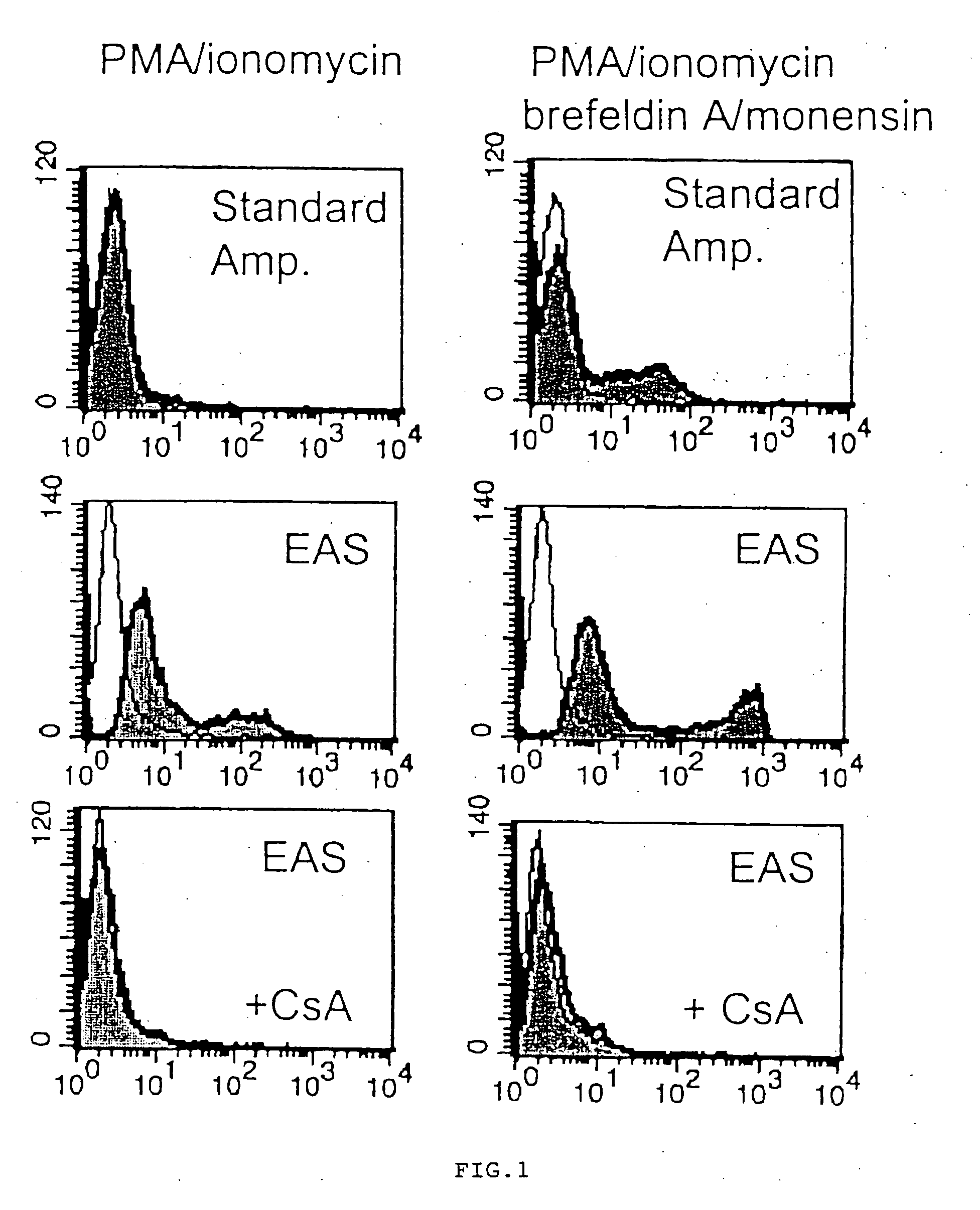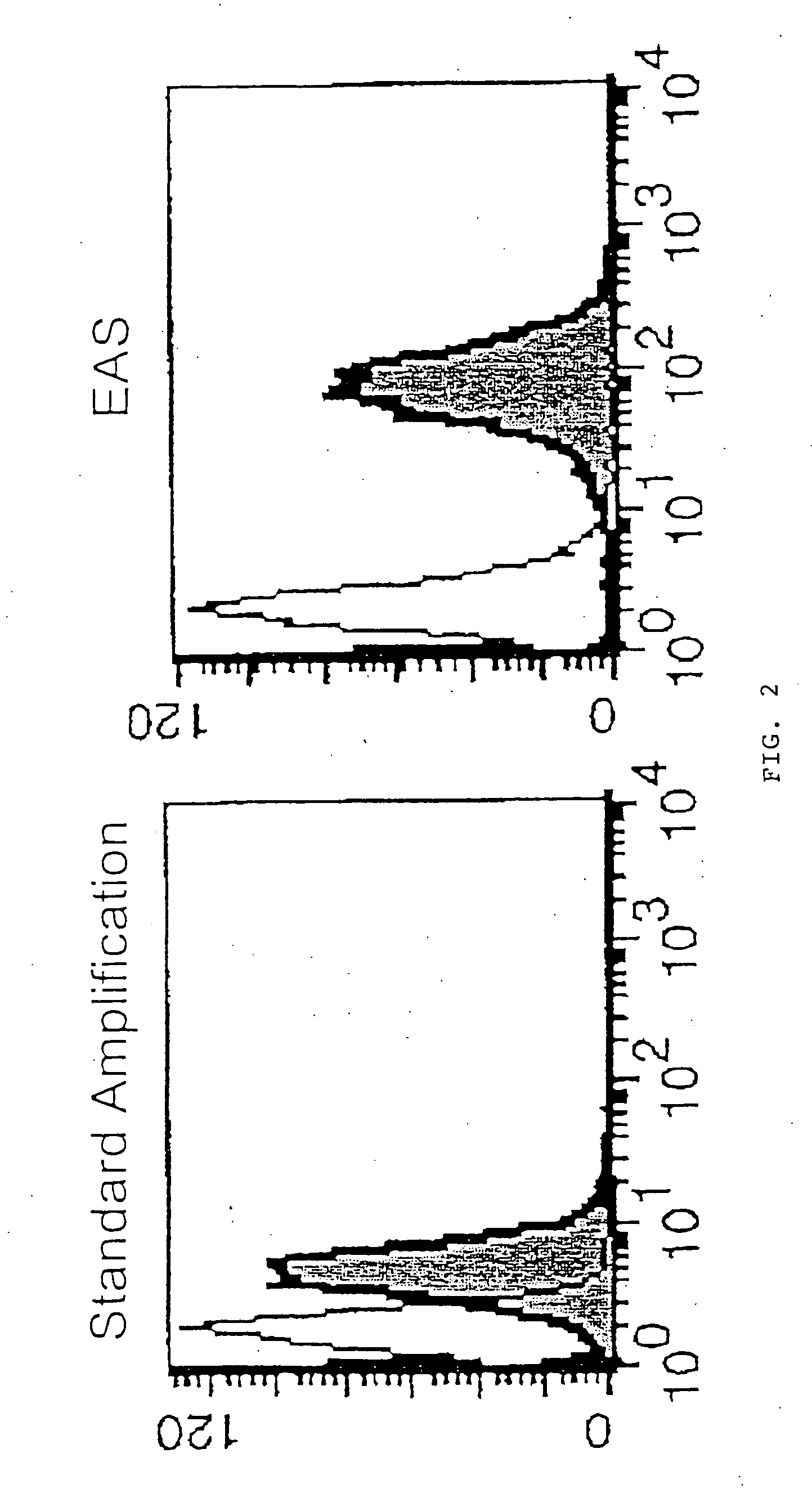Methods for detecting an analyte of interest using catalyzed reporter deposition of tyramide
a reporter and catalyzed technology, applied in the field of catalyzed reporter deposition of tyramide, can solve the problems of high level of spontaneous activation and non-specific binding of fluorescent substrates to live cell membranes, difficult direct detection of fluorochrome-labeled tyramide, etc., to achieve enhanced detection signal and improve catalyzed reporter deposition staining
- Summary
- Abstract
- Description
- Claims
- Application Information
AI Technical Summary
Benefits of technology
Problems solved by technology
Method used
Image
Examples
example 1
Detection of Cytokines
[0115] Human peripheral blood mononuclear cells were cultured in RPMI 1640 medium +10% fetal bovine serum, containing 10 ng / ml phorbol myristic acetate and 500 ng / ml ionomycin, with or without 3 μM monensin and 10 μM brefeldin A, at 37° C. for 5 hours to induce expression of Interleukin 2. In some cultures, 10 μg / mL of cyclosporin A (an inhibitor if IL-2 induction) was included.
[0116] The cells were then harvested and fixed in 100 μL of 1% paraformaldehyde in phosphate buffered saline (PBS) at room temperature for 10 minutes, then permeabilized overnight at room temperature in 100 μL of 0.2% saponin, 3% hydrogen peroxide, and 1 mg / mL milk proteins in PBS. The cells were then washed in a PBS diluent (consisting of PBS with 1% bovine serum albumin and 1% fetal bovine serum).
[0117] The cells were then treated for 10 minutes at room temperature with 500 ng mouse IgG1 or 500 ng mouse IgGI1 anti-human interleukin 2 primary antibody (R&D Systems).
[0118] After bein...
example 2
Detection of Intracellular Antigens
[0123] Approximately one million cells were washed in PBS, followed by incubation with 0.1 mL of 1% paraformaldehyde in PBS for 10 minutes at room temperature to fix the cells.
[0124] The cells were washed in PBS and then incubated with 0.1 ml of 0.2% saponin, 3% hydrogen peroxide, and 1 mg / mL milk proteins in PBS for 10 minutes at room temperature. This step permeabilizes the cells, inhibits endogenous peroxidases, and blocks nonspecific binding.
[0125] The cells were washed in a PBS diluent (consisting of PBS with 1% bovine serum albumin, 1% fetal bovine serum, which may or may not contain 0.2% saponin). The cells were then incubated for 10 minutes at room temperature with 0.05 mL of an unconjugated primary antibody in the same PBS diluent. The concentration of the antibody can vary, depending on the antibody used. Optimal antibody concentration is determined empirically. Unbound antibody is then washed out of the cells with the PBS diluent.
[01...
example 3
Detection of Cellular RNA Sequences
[0130] Approximately one million cells were incubated for 10 min at about 22° C. in 100 μL of a solution consisting of 2% paraformaldehyde in phosphate-buffered saline (PBS). The cells were washed once in PBS, followed by a 15 minute incubation at about 22° C. in 1 ml of a solution consisting of 0.2% diethyl-pyrocarbonate in 50% ethanol / 50% PBS. This solution was made fresh daily. For all subsequent steps, all solutions were treated with 0.2% diethyl-pyrocarbonate for 10 min. at about 22° C. to destroy any RNase present, and then autoclaved to destroy the chemical.
[0131] The cells were subsequently washed twice with PBS and then incubated for 10 min at about 22° C. in 3% hydrogen peroxide and 1 mg / ml milk proteins in PBS. After this step, the cells were washed in 4×SCC containing 5 mM sodium phosphate, pH 7.4, and 50% formamide. The 4×SSC was diluted from a 20×SCC stock (175.3 grams sodium chloride +88.2 grams sodium citrate +00 ml deionized (DEP...
PUM
 Login to View More
Login to View More Abstract
Description
Claims
Application Information
 Login to View More
Login to View More - R&D
- Intellectual Property
- Life Sciences
- Materials
- Tech Scout
- Unparalleled Data Quality
- Higher Quality Content
- 60% Fewer Hallucinations
Browse by: Latest US Patents, China's latest patents, Technical Efficacy Thesaurus, Application Domain, Technology Topic, Popular Technical Reports.
© 2025 PatSnap. All rights reserved.Legal|Privacy policy|Modern Slavery Act Transparency Statement|Sitemap|About US| Contact US: help@patsnap.com



